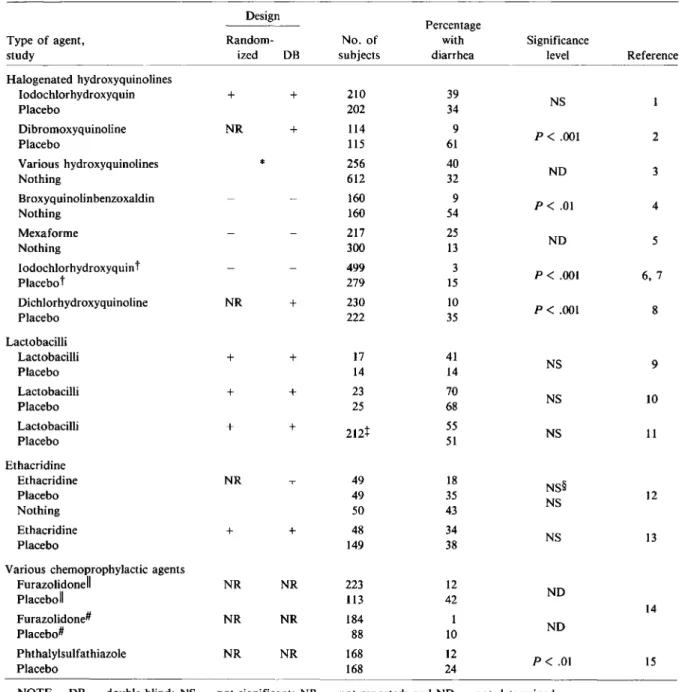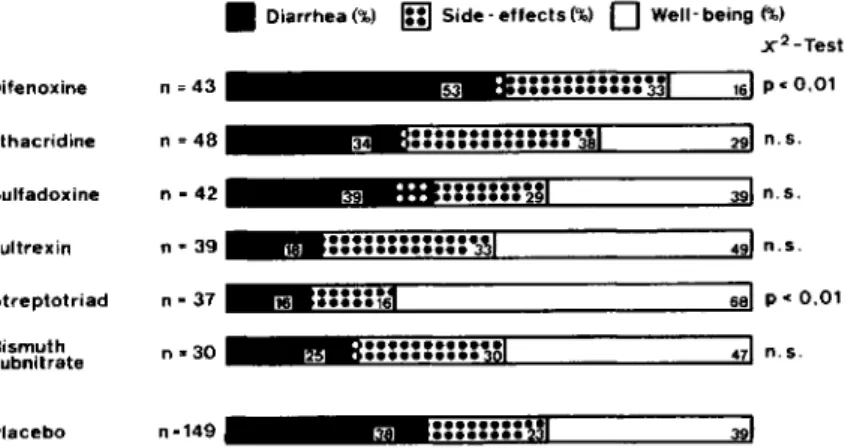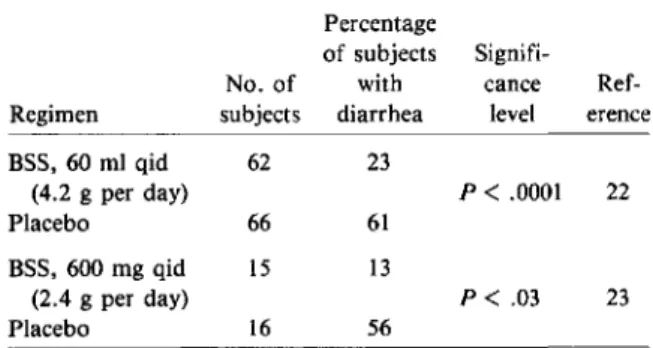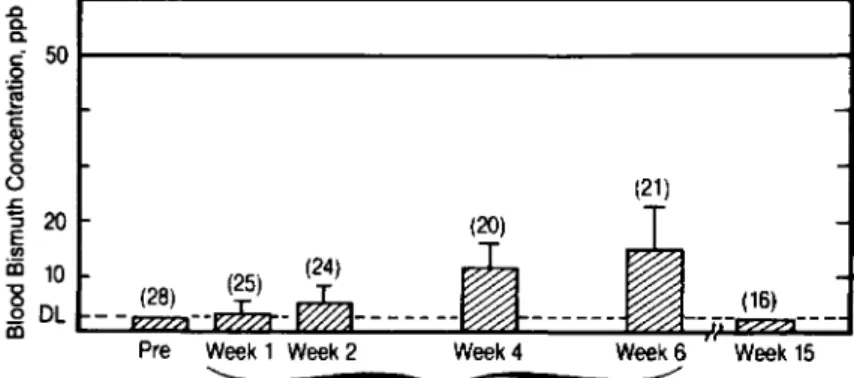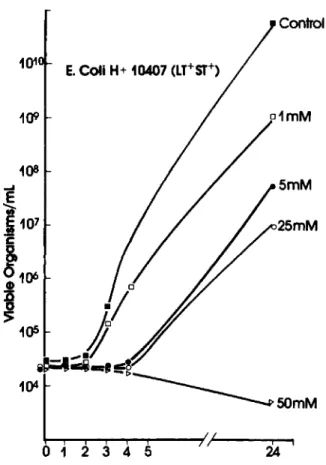Prevention of Travelers' Diarrhea
byNonantibiotic Drugs
Robert Steffen, Rolf Heusser, and HerbertL. DuPont From the Institute for Social and Preventive Medicine, University of Zurich, Zurich, Switzerland; and the University of Texas Health Science Center at Houston, The Medical School, Houston, Texas
Travelers have resorted to a variety of drugs for prevention of diarrhea. No beneficial prophylactic effect has been confirmed for halogenated hydroxyquinolines, lactobacilli, anti motility drugs, ethacridine, and various other agents. In contrast, bismuth subsalicy-ate (BSS) in liquid form reduced the incidence of diarrhea in students from the United States living in Mexico and in tablet form in volunteers challenged by enterotoxigenic
Escherichia coli.In tourists visiting various developing countries, a randomized, double-blind study was conducted in which 390 persons received a total of 2.1 or 1.05g of BSS daily or placebo in tablet form in two doses. BSS reduced the incidence of diarrhea by 41%in the high-dose group and by 35% in the low-dosegroup without causing important adverse reactions.
Since the advent of mass travel to exotic tropical des-tinations, travelers have resorted to a variety of drugs for the prevention of travelers' diarrhea. In 1957Kean
[1]observed that of 1,265 residents of the United States returning from Mexico, 35% had taken prophylactic medication. According to the author, this figure might have been a slight overestimate of the incidence of prophylaxis. In our more recent sur-veys, we have found that, depending on their desti-nation, 10%-250,10 of European travelers take some medication to prevent emporiatric enteritis. Despite the fact that, at least in Europe, we have observed a definite trend away from prophylaxis to therapy by self-medication, the findings of these surveys in-dicate that it is important to evaluate the effective-ness of prophylaxis. Few data exist from which to judge such trends in travelers from the United States, but it is our impression that chemoprophylaxis is em-ployed in nearly one-half of travelers to high-risk areas. Of the various antidiarrheal agents used, many have not been studied for prevention of travelers' di-arrhea. We have limited our evaluation of nonan-tibiotic drugs in prophylaxis of travelers' diarrhea to six groups of agents.
Hydroxyquinolines
The first agents to be broadly used for prophylaxis were halogenated hydroxyquinolines. They were orig-inally introduced in1934 for use in the treatment of
Please address requests for reprints to Dr. Robert Steffen, In-stitute for Social and Preventive Medicine, University of Zurich, Sumatrastrasse 30, CH-8006 Zurich, Switzerland.
S151
intestinal amebiasis. However, it was not until 1958 that their efficacy in the prophylaxis of travelers' di-arrhea was evaluated. Kean [1] recruited students from the United States and Canada during college registration for study in Mexico (table 1). Unfortu-nately, it was impossible to enroll all the study popu-lation before or immediately on their arrival; enroll-ment usually took place on the third day abroad. Using a randomized, double-blind method, Kean compared the efficacy of iodochlorhydroxyquin, which is available commercially as Entero-Vioform (dosage, 375 mg twice a day), with that of neomycin and a placebo. Whereas neomycin was effective, those who were taking iodochlorhydroxyquin showed a slightly increased incidence of diarrhea as com-pared with those who were taking placebo. Similarly, in the subgroup who started drug prophylaxis on the first day abroad, the active agent did not reduce the incidence of diarrhea. No adverse reactions were reported.
In a second study, a Swedish group investigated the efficacy of dibromoxyquinoline in Scandinavian tourists who were vacationing in the Canary Islands [2].Itis uncertain how the assignment of the tourists to the drug groups was randomized. The active drug was found to be distinctly superior to a placebo. Again, not a single person complained about adverse effects, which is surprising in view of the consider-able frequency of such complaints obtained nowa-days - even in placebo groups. Mentzing [3] then per-formed a retrospective assessment of travelers who had returned to Sweden. He demonstrated that those who had taken one of a variety of hydroxyquino-lines were more likely to have developed diarrhea,
S152 Steffen, Heusser, and DuPont
Table 1. Efficacy of nonantibiotic prophylaxis of travelers' diarrhea.
Design
Percentage
Type of agent, Random- No. of with Significance
study ized DB subjects diarrhea level Reference
Halogenated hydroxyquinolines Iodochlorhydroxyquin + + 210 39 NS Placebo 202 34 Dibromoxyquinoline NR + 114 9 P<.001 2 Placebo 115 61 Various hydroxyquinolines * 256 40 Nothing 612 32 NO 3 Broxyquinolinbenzoxaldin 160 9 P<.01 4 Nothing 160 54 Mexaforme 217 25 NO 5 Nothing 300 13 Iodochlorhydroxyquint 499 3 P<.001 6,7 Placebo" 279 15 Dichlorhydroxyquinoline NR + 230 10 P<.001 8 Placebo 222 35 Lactobacilli Lactobacilli + + 17 41 NS 9 Placebo 14 14 Lactobacilli + + 23 70 NS 10 Placebo 25 68 Lactobacilli + + 212t 55 NS 11 Placebo 51 Ethacridine Ethacridine NR 49 18 NS§ Placebo 49 35 12 Nothing 50 43 NS Ethacridine + + 48 34 NS 13 Placebo 149 38
Various chemoprophylactic agents
FurazolidoneII NR NR 223 12 NO PlaceboII 113 42 Furazolidonef NR NR 184 I 14 NO Placebo# 88 10 Phthalylsulfathiazole NR NR 168 12 P< .01 15 Placebo 168 24
NOTE. DB = double-blind; NS = not significant; NR = not reported; and NO = not determined.
*Retrospective study.
tTwice a day, three times a day, and four times a day in three respective trials. t The total number of subjects in the study.
§P<.02 for the comparison of ethacridine vs. nothing.
IIOnce a day. # Twice a day.
notably salmonellosis.Itremains debatable whether the treated and nontreated groups were drawn from equivalent populations.
Other uncontrolled studies have looked at the ef-fectiveness of iodochlorhydroxyquin in the
preven-tion of travelers' diarrhea [4-8] (table 1). Because of the association of the drug with the syndrome of subacute myelooptic neuropathy (SMON), which oc-curs primarily in Japan [16] and rarely in other coun-tries [17], use of this agent cannot be recommended.
Lactobacilli
On the assumption that lactobacilli favorably mod-ify the intestinal flora, the efficacy of the commer-cial preparation Lactinexwas tested by two groups: Pozo-Olano et al. [9], who conducted their trial in travelers to Mexico, and Clements et al.[10], who challenged volunteer college students with virulent enterotoxigenicEscherichia coli(ETEC). Recently, Kollaritsch et al. [11] distributed a similar dose of
Lactobacillus acidophilusto travelers. In each one of the three studies it was concluded that ingestion of lactobacilli did not reduce the incidence of travelers' diarrhea.
Ethacridine
In the aforementioned pilot study [13], ethacridine, a local antiseptic agent that was used by the Ger-mans to treat diarrhea in World War II, was reas-sessed. Richarz [12] claimed that it had a significant beneficial effect in participants on a world cruise, but he compared the treated group with untreated travelers rather than with the placebo group. In our pilot study, no reduction in the incidence of diar-rhea was observed, and adverse reactions, mainly nausea, were reported by 38% of those receiving ethacridine, as compared with 230,10 of those in the placebo group.
Antimotility Drugs
As Merson [18] has stated, diphenoxylate, which is marketed as Lomotil, was used, and antimotility agents are still used on occasion for prophylaxis of emporiatric enteritis. However, the efficacy of di-phenoxylate for this indication has not been tested. In contrast, we have tested the efficacy of the ac-tive metabolite of diphenoxylate, difenoxine [19], in a controlled pilot study (figure 1). As previously de-scribed [13], we evaluated the efficacy of six differ-ent compounds among 653 tourists visiting Sri Lanka or Kenya. Difenoxine was included in this trial only because its distributor intended to promote its use for prophylaxis of travelers' diarrhea. Difenoxine sig-nificantly reduced the rate of well-being, partly by an increase in the incidence of diarrhea and partly by an increase in the rate of adverse reactions-mainly constipation. We concluded that antimotil-ity drugs are not to be recommended for prophylaxis of travelers' diarrhea.
Other Chemotherapeutic Agents
In our study [13], which was conducted mainly to exclude ineffective or even harmful agents from a larger survey that is currently under way, we evalu-ated various chemotherapeutic agents (figure 1). Nei-ther sulfadoxine nor a preparation containing thiam-phenicol, nitrafurantoin, and sulfafurazole, with the trade name Fultrexin (Inpharzam, Cadempino, Swit-zerland), significantly reduced the rate of diarrhea. Only Streptotriad (May and Baker, Dagenham, United Kingdom), which contains streptomycin and three sulfonamides, which is discussed in more de-tail in these proceedings by Sack [20], reduced the rate of diarrhea and increased the rate of well-being significantly.
More than 20 years ago, phthalylsulfathiazole [15] and furazolidone [14] were reported to exert a prophylactic effect without serious adverse effects, but neither agent is widely used at the present time. An additional preparation,
trimethoprim-sulfameth-• Diarrhea(%) In)Side - effects(%)
0
Well- being(%)x2- Te st 5~W;:::::::::::~JI
3§_::::::::MI
3 ::::::::::::::~,3tA"I::::::n31
;;.::::::::::301
'.::::::::::::·3~116i::::nJl
••••••••
Bm~~~m=~161pcO,01 Difenoxine n=43 Ethacridine n=48 Figure 1. Efficacy of drugprophylax-is of travelers' diarrhea (n.s. = not sig- Sulfadoxine n - 42 nificant). Figure is from a study [13]
conducted with653subjects from1979 Fultrexin n=39
to 1980; 388cases were assessable.
Streptotriad n>37 Bismuth n .. 30 subnitrate
S154 Steffen, Heusser, and DuPont o bismuth subsalicylate • placebo
•
• ••••••
• • •
•
7•
•
•
•
5 i o o o o o o • 0 0 0 0 0 0 0 0 0 0 0 3 1.00 0.90 0.80 0.70 0.60 0.50 0.40 0.30 0.20 0.10did not become ill, enteropathogens were detected in approximately equal numbers in both treatment groups. In contrast, in the patients with diarrhea, an enteropathogen was identified in the stools of 71% of the placebo-treated vs. 33 % of the BSS-treated students (P
<
.05). Gorbach [25], who has com-mented that if travelers were to take BSS at the large dose used in this study - 60 ml four times a day-they would need to take an extra suitcase just for their BSS bottles, concluded that this might provide space with which to bring home souvenirs once the drug was consumed. This dose had been arbitrarily chosen in the study [22], and in the report we ac-knowledged the need to determine the minimum pro-tective dose.Using volunteers who were challenged with ETEC in a double-blind, placebo-controlled study, Graham et al. [23] set out to determine this dose in a study of the efficacy of the tablet form of BSS. Adminis-tration of 600 mg of BSS in the form of two tablets was begun 8 hr before challenge with ETEC and was then continued 2 hr before challenge with ETEC and 2 hr and 4 hr after challenge and on a four-times-daily regimen for three additional days. Volunteers consumed a total daily dose of 2.4 g of BSS, which was approximately one-half that used by DuPont et al. in the earlier study [22]. Again, the drug not only reduced to a significantextent the incidence of diarrhea - the protection rate was 77% - but the two subjects receiving BSS who had diarrhea were the only ones who did not experience accompanying symptoms such as nausea, vomiting, cramps,
head-9 11 ' 13I1'5I1'7I19 ' 2'1 Day
Figure 2. Plot-estimated probabilities of a subject re-maining free of illness over 21 days of prophylaxis with bismuth subsalicylate or placebo. The difference between the two "survival" patterns, as assessed by the log-rank method [24], was statistically significant (P
<
.001). Reprinted with permission from lAMA [22].Bismuth Subsalicylate (BSS)
Bismuth compounds were introduced to medicine in the 18th century for the treatment of syphilis, yaws, and various gastrointestinal disorders. In the 1920s bismuth replaced mercury as the heavy metal of choice for the intravenous treatment of syphilis un-til its use started to decline with the discovery and application of penicillin therapy. The value of bis-muth salts in treating gastrointestinal disorders has remained unconfirmed [21]. Controlled studies have recently demonstrated that one bismuth salt, bismuth subsalicylate, is effective in both treatment and pro-phylaxis of travelers' diarrhea.
The initial studies that investigated BSS as a prophylactic agent were carried out in 1977 among students from the United States who were attending summer classes in Guadalajara, Mexico [22]. The volunteers who took the liquid form of the active agent (4.2 g per day) experienced a lower incidence of illness of both mild and moderate levels of severity (table 2). They also experienced fewer other intesti-nal symptoms. The probabilities of the BSS and placebo groups remaining free of diarrhea during the 21-day study are illustrated in figure 2. The pro-tection rate, which is defined as the reduction in in-cidence of diarrhea between the drug and placebo treatments and which is expressed as a percentage such that 1000/0 indicates maximal protection, was 62%. The preparation was well tolerated; it is nota-ble that the percentages of students with constipa-tion (34% in the drug vs. 27% in the placebo group) were not significantly different. Of the students who oxazole, can be considered a nonantibiotic com-pound for prophylaxis, but this agent will be dis-cussed separately.
NOTE. Both studies were randomized and double-blind.
Table 2. Efficacy of bismuth subsalicylate (BSS) for prevention of travelers' diarrhea.
Percentage
of subjects Signifi-No. of with cance Ref-Regimen subjects diarrhea level erence BSS, 60 ml qid 62 23 (4.2 g per day) P<.0001 22 Placebo 66 61 BSS, 600 mg qid 15 13 (2.4 g per day) P< .03 23 Placebo 16 56
ache, or fever. Further, ETEC were recovered from the stools of only a few of those receiving a placebo. In addition, in one-half of those receiving BSS, an antibody response to the organism's adhesion fim-briae (CFA I) was demonstrated even in the absence of the development of diarrhea.
To establish a minimal effective prophylactic dose and to test the efficacy of a tablet formulation of BSS in tourists - the population to whom it might later be most frequently recommended - we recently conducted a randomized, triple-blind study evalu-ating BSS as prophylaxis of travelers' diarrhea (authors' unpublished observations). Three treat-ment regimens were tested: two 525-mg BSS tablets taken twice daily, two 262.5-mg BSS tablets taken twice daily, and a placebo. Subjects took the medi-cation continuously from the day before departure during the 12-28-day stay in the tropics, until the second day after returning home. Three hundred ten subjects were originally recruited for the study. Twenty-six percent of the persons visited Kenya;23070,
West Africa; 13%, other parts of Africa;23070, Asia
east of India; and 15070, South America. After the
exclusion of noncompliant subjects or subjects with nonassessable cases, 231 volunteers could be included in the evaluation of efficacy. The participants were divided into two groups according to the degree of compliance. Excellent compliance was defined as the taking of all but six or fewer tablets of the medica-tion. Fair compliance was defined as the missing of no more than 20 doses.
For both the fair- and excellent-compliance sub-groups, the incidence of diarrhea in both the
high-and low-dosage groups was significantly reduced as compared with that in the placebo group (table 3). The high incidence of diarrhea in the placebo-group as compared with the incidence found in our epidemiologic studies [26] might primarily be ex-plained by the fact that persons who are prone to suffer from diarrhea were more likely to enroll in the trial. The rates of protection against traveler's diarrhea are shown in table 3. No differences in the efficacy of BSS for travelers to different regions were observed.
A comparison of our results with those of Gra-ham et al. [23] indicates that the frequency of dos-ing plays an important role in efficacy, since 2.4 g of BSS given in four doses provided twice the pro-tection of 2.1 g given in two doses.
In our study, overall adverse effects were reported more frequently in both BSS-treated groups than in the placebo group(P
=
.04). Constipation and nau-sea were the principal complaints.With respect to toxicity, it is important to note that BSSis composed of approximately60070 bismuth and
40% salicylate. It is hydrolyzed in the stomach to bismuth oxychloride and salicylate.Over90070 of the
salicylate is absorhed from the gastrointestinal tract and excreted into the urine [27, 28]. In the first study of BSS as prophylaxis [22], the amount of salicylate in the liquid preparation administered to each sub-ject corresponded to that in 8.3 325-mg aspirin tablets per day, which is consistent with therapeutic doses of aspirin. This daily dose of BSS would have been equivalent to 3.3 aspirin tablets if the tablet for-mulation had been used. Although it is not known
Table 3. Prophylactic efficacy of bismuth subsalicylate (BSS) in travelers' diarrhea.
Travelers' diarrhea Type of
compliance, No. of Did not Incidence Significance Protection daily regimen* subjects Developed develop (010) level rate(010)
Fair 2.1 g of BSS 88 38 50 43.2 P = .014 32.4 1.05 g of BSS 71 31 40 43.7 P = .024 31.6 Placebo 72 46 26 63.9 Total 231 Excellent 2.1 g of BSS 67 26 41 38.8 P = .007 40.6 1.05 g of BSS 54 23 31 42.6 P = .031 34.8 Placebo 52 34 18 65.4 Total 173
NOTE. Excellent compliance was defined as the taking of all but six or fewer tablets of BSS; fair, as the taking of all but up to 20 tablets.
SI56
whether BSS cross-reacts with aspirin, patients with a history of aspirin-associated allergy should refrain from taking BSS-containing products. In addition, care should be exercisedin the administration of BSS to patients receiving anticoagulant therapy, persons with gout, and persons taking probenecid, metho-trexate, or other medications that contain aspi-rin [29].
Between 1973and 1980, approximately 1,000cases of bismuth-related encephalopathy were observed in France [30, 31] and an additional 40 cases, in Aus-tralia [32]. This adverse reaction has also been reported in 12cases in four other countries [21]. Most cases involved the ingestion of large quantities of bis-muth sub nitrate or bisbis-muth subgallate (up to 20 g) on a daily basis for as long as 30 years. None of the patients had a levelof bismuth in blood of <100 parts per billion (ppb) [33]. Despite the fact that BSS was introduced early this century, only one case of en-cephalopathy due to BSS has been reported - in Aus-tralia [34]. This occurred in a 60-year-old man who had taken a BSS preparation for a number of years in unknown doses for chronic diarrhea. In addition, this subject was diabetic, had a history of chronic ulcerative colitis, and had undergone surgery for pro-tocolectomy, ileostomy, and splenectomy. No cases of bismuth-induced encephalopathy due to BSS have been reported in North America or have been as-sociated with the use of Pepto-Bismol (Proctor&
Gamble, Cincinnati).
Hillemand et al. [35] have published a review on the relationship of blood bismuth levels and enceph-alopathy. They concluded that levels of >100 ppb were toxic, levels of between 50 and 100 ppb were considered an "alarm value," and levels of <50 ppb were acceptable and should not produce signs of bismuth-induced encephalopathy. .J:l Q. Q. c- 50 0 ~ 'E Q) 0 c 0 o (21) .s:::. 'S 20 E f1l iii 10
~
DL mWeek 1 Week 2 Week 4 Week 6
'---...---'
3.14 gm Bismuth Subsalicylate/day doseRegimenSteffen, Heusser, and DuPont
All of the 10travelers whom westudied who volun-teered to give a blood sample within five days after the cessation of treatment had bismuth values that did not exceed 10ppb. In the blood samples that had been obtained in a previous study [22] from six sub-jects within 24 hr of their discontinuation of daily ingestion of 4.2 g of BSS for 21 days, all levels were below the assay detection limit of 50 ppb [36].
In a study conducted by Procter& Gamble (un-published data), 30 subjects were administered three Pepto-Bismol tablets either four times a day (3.14 g of BSS per day) or twice a day (1.57 g of BSS per day) for six weeks. Blood samples were analyzed for 'bismuth before the start of treatment, at the end of weeks 1, 2, 4, and 6 of treatment, and nine weeks after cessation of treatment. The mean ± SD blood bismuth levels of subjects taking 1.57 and 3.14 g of BSS per day were 10.0 ± 6.6 and 15.0 ± 7.9 ppb, respectively, at the end of six weeks of treatment. Figure 3 shows the mean blood bismuth values ob-served during this study in the four-times-a-day group. The highest blood bismuth levelwas recorded in an individual receiving the low dose at week 4 (34
ppb),None of the subjects showed any signs ofneu-rotoxicity, and all blood bismuth levels decreased to below the detection limit at nine weeks posttreat-ment. Results of this study suggest that bismuth, un-like salicylate, is poorly absorbed from the gastroin-testinal tract. In addition, there is no evidence to suggest that BSS, when taken by adults in reason-able doses for up to three weeks for prophylaxis, would result in bismuth-related encephalopathy.
Levine [37] has pointed out that Pepto-Bismol tablets, unlike the liquid form, contain 350 mg of calcium carbonate. Although most persons are able to excrete excess calcium, it has been suggested that prophylactic treatment with BSS tablets in some
in-Figure 3. Bioavailability of bismuth after ingestion of 3.14g of bismuth sub-salicylate per day in divided doses four times daily. Reprinted with permission from an unpublished study (IB-I01; Proctor& Gamble, Cincinnati).
Figure 4. Dose-dependent inhibition of growth of en-terotoxigenic Escherichia coli by bismuth subsalicylate. Overnight cultures of ETEC weregrown in braheart in-fusion broth (BHI). Growth in the presence of the com-pounds was examined by inoculating 30 ml of BHI con-taining the compound with 0.1 ml of a late log-phase culture and incubating at 37°C on a rotating platform. Abbreviations: LT =heat-labile; ST =heat-stable (en-terotoxin properties). Figure is from [39].
tant strains in regions frequently visited by tourists [43]. The data presented suggest that only one nonantibiotic agent, BSS, be considered for prophy-laxis. BSS has been repeatedly tested under con-trolled conditions and appearstobe safe and effec-tive in the prevention of travelers' diarrhea. The reported studies of BSS suggest that the dosage and especially the number of daily doses are important. One gram of BSS daily taken in two divided doses appears to be the minimum efficacious dose, but a protection rate in the range of 400/0 is not sufficient. However, on the basis of the earlier studies [22, 23], the traveler can be protected satisfactorily with a slightly higher dose when the drug is taken more fre-quently. Because of the convenience of the solid prep-aration, we currently recommend it and suggest that dividuals may produce a hypercalcemia via the
milk-alkali syndrome. The minimum amount of calcium reported to produce this syndrome exceeds that con-sumed in the recommended prophylactic dose. In ad-dition, the Food and Drug Administration has con-cluded in its review of over-the-counter antacid ingredients that up to 8 g of calcium carbonate may be consumed daily [38], a value in excess of any rea-sonable prophylactic dose of BSS.
Recently, evidence has been put forward to sug-gest a mechanism of action of BSS. The decreased recovery of enteropathogens from the stools of pa-tients given BSS in the earlier studies [22, 23] im-plies that BSS may have bactericidal activity. Gra-ham reported that the challenge strain that was used in his study was sensitive to BSS. Further, Manhart [39] demonstrated in vitro that BSS and, to a lesser extent, bismuth oxychloride and salicylate, inhibited growth of the most common enteropathogens at con-centrations that are likely to be achieved in the up-per small intestine (figure 4). Additionally, salicy-lates have been shown to exhibit an antisecretory effect by increasing net water absorption in intesti-nal tissue after exposure to bacterial toxins [40, 41]. The reduced serologic response to infection in ex-perimentally induced ETEC infection by pretreat-ment with BSS suggests that the drug may interfere with attachment of organisms to intestinal receptors. Additionally, in a series of in vitro studies, the inhi-bition by BSS of crude toxins ofE.coliandVibrio choleraewas demonstrated [42].Itshould be noted that neither bismuth subcarbonate [36] nor bismuth subnitrate [13] showed a significant prophylactic ef-fect. Although there is evidence that a number of factors may contribute to the overall efficacy of BSS, precisely how and to what extent each of the com-ponents contributes to the action of BSS remains to be elucidated.
Conclusions
Three types of prophylaxis of travelers' diarrhea are available to the traveler. The first approach, to take no prophylaxis at all, is very reasonable, at least for the majority of travelers to the developing world-with the possible exceptions of the high-risk travelers described previously and of those who have to ful-fill important tasks during a brief stay abroad. Prophylactic antibiotics are an alternative but cer-tainly have the important disadvantages of poten-tial serious adverse effects and induction of
resis-101 1()9 E. Coli H+ 10407 (LY+ $T+) Control o1mM 5mM 25mM
SI58
it be administered in a dose of two tablets (262.5 mg per tablet) three times a day (with meals) during the period at risk for up to three weeks. This dosing schedule represents an extrapolation from the studies reported herein. The efficacy of this approach re-mains to be investigated.
References
I. Kean BH, Waters SR. The diarrhea of travelers. III. Drug prophylaxis in Mexico. N Engl J Med 1959;261:71-4 2. Hyllner S, Heinlaid H, Thorsson KG. Fenilor
(dibromoxikino-lin) - ett nytt tarmantiseptikum. Svenska Lakartidingen 1962;59:2431-54
3. Mentzing LO, Ringertz O. Salmonella infection in tourists. 2. Prophylaxis against salmonellosis. Acta Pathol Microbiol Scand 1968;74:405-13
4. Marth W. Prospektive Untersuchungen iiber Urlaubsdiar-rhoen. Therapie der Gegenwart 1968;107:1053-62 5. Malot J, Jaouen H. Essai de prophylaxie des diarrhees dites
"de voyage." Revue d'Informations du Corps Medical 1971;31:11-14
6. Richards DA. A controlled trial in travellers' diarrhoea. Prac-titioner 1970;204:822-4
7. Richards DA. Prophylactic value of clioquinol against travellers' diarrhoea [letter]. Lancet 1971;1:44-5 8. Havlik J, Kocna A. Chemoprofylaxe tzv. prujmu cestovatelu.
Cas Lek Cesk 1977;116:199-201
9. Pozo-Olano J de D, Warram JH Jr, Gomez RG, Cavazos MG. Effect of a lactobacilli preparation on travelers's diarrhea: a randomized double-blind clinical trial. Gastroenterol-ogy 1978;74:829-30
10. Clements ML, Levine MM, Black RE, Robins-Browne RM, Cisneros LA, Drusano GL, Lanata CF, Saah AJ.
Lac-tobacillusprophylaxis for diarrhea due to enterotoxigenic
Escherichia coli. Antimicrob Agents Chemother 1981;20:104-8
11. Kollaritsch H, Sternberger H, Ambrosch P, Ambrosch F, Widermann G. Prophylaxe der Reisedi:: rrhomit einem Lyophilisat von Lactobacillus acidophilus[a.stracrno. 92]. In: Gemeinsame Tagung der Deutschen Tropen-medizinischen Gesellschaft, Oesterreichischen Gesellschaft fur Tropenmedizin und Parasitologie, Schweizerischen Gesellschaft fur Tropenmedizin und Parasitologie. Garmisch-Partenkirchen, Federal Republic of Germany, 1983
12. Richarz A. Prophylaktische und therapeutische Wirkung von Aethacridinlaktat bei unspezifischen Durchfallerkrankun-gen. Medizinische Klinik 1967;62:1308-10
13. Steffen R, Gsell O. Prophylaxis of traveller's diarrhoea. J Trop Med Hyg 1981;84:239-42
14. Nelson SRC, Jones HL, Ross JB. Trial of furazolidone as a prophylactic in 'traveller's diarrhoea.' Practitioner 1962;188:654-5
15. Kean BH, Schaffner W, Brennan RW, Waters SR. The diar-rhea of travelers. V. Prophylaxis with phthalylsulfathia-zole and neomycin sulphate. JAMA 1962;180:367-71 16. Tsubaki T, Honma Y, Hoshi M. Neurologic syndrome
as-sociated with clioquinol. Lancet 1971;1:696-7
Steffen, Heusser, and DuPont
17. Baumgartner G, Gawel MJ, Kaeser HE, Pallis CA, Rose FC, Schaumburg HH, Thomas PK, Wadia NH. Neurotoxic-ity of halogenated hydroxyquinolines: clinical analysis of cases reported outside Japan. J Neurol Neurosurg Psychiat 1979;42:1073-83
18. Merson M. Toxigenic turista [editorial]. N Engl J Med 1975;292:969-70
19. Rubens R, Verhaegen H, Brugmans J, Schuermans V. Difenoxin (R 15403), the active metabolite of diphenoxy-late (R 1132). 5. Clinical comparison of difenoxine and diphenoxylate in volunteers and in patients with chronic diarrhea. Arzneimittel-Forschung. Drug Research 1972; 22:526-9
20. Sack RB. Antimicrobial prophylaxis of travelers' diarrhea: a selected summary. Rev Infect Dis 1986;8(SuppI2):SI60-6 21. Winship KA. Toxicity of bismuth salts. Adverse Drug
Reac-tion and Drug Poisoning Reviews 1983;2:103-21 22. DuPont HL, Sullivan P, Evans EG, Pickering LK, Evans OJ,
Vollet J J, Ericsson CD, Ackermann PB, Tjoa WS. Preven-tion of traveler's diarrhea (emporiatric enterititis): prophylactic administration of sub salicylate bismuth JAMA 1980;243:237-41
23. Graham DY, Estes MK, GentryW. Double-blind compari-son of bismuth subsalicylate and placebo in the preven-tion and treatment of enterotoxigenicEscherichia
coli-induced diarrhea in volunteers. Gastroenterology 1983;85:1017-22
24. Peto R, Pike MC, Armitage P, Breslow NE, Cox DR, Howard SV, Mantel N, McPherson K, Peto K, Smith PG. Design and analysis of randomized clinical trials requiring prolonged observation of each patient. II. Analysis and examples. Br J Cancer 1977;35:1-39
25. Gorbach SL. How to avoid running withEscherichia coli.
JAMA 1980;243:260-1
26. Steffen R, van der Linde F, Gyr K. Schar M. Epidemiology of diarrhea in travelers. JAMA 1983:249:1176-80 27. Feldman S, Chern S-L, Pickering LK, Cleary TG, Ericsson
CD, Hulse M. Salicylate absorption from a bismuth sub-salicylate preparation. Clin Pharmacol Ther 1981;29:788-92 28. Pickering LK, Feldman S, Ericsson CD, Cleary TG. Absorp-tion of salicylate and bismuth from a bismuth subsalicy-late-containing compound (pepto-Bismol). J Pediatr 1981; 99:654-6
29. Henderson IWD. Warning against products containing bis-muth sub salicylate [letter]. Can Med Assoc J 1980;123:848 30. Buge A, Supino-Viterbo V, Rancurel G, Pontes C. Epileptic
phenomena in bismuth toxic encephalopathy. J Neurol Neurosurg Psychiatry 1981;44:62-7
31. Galland MC, Rodor F, Jouglard J. Bismuth et en-cephalopathie, Medecine et Hygiene 1979;37:2579-82 32. Burns R, Thomas DW, Barron VJ. Reversible
encephalopa-thy possibly associated with bismuth subgallate ingestion. Br Med J 1974;1:220-3
33. CarruzzoF.L'encephalopathie bismuthique myoclonique: une intoxication insolite. Rev Med Brux 1980;21:997-1000 34. Hasking GJ, Duggan JM. Encephalopathy from bismuth
sub-salicylate [letter]. Med J Aust 1982;2:167
35. Hillemand P, Palliere M, Laquais B, Bouvet P. Traitement bismuthique et bismuthemie, Sem Hop Paris 1977;53: 1663-9
36. Ericsson CD, DuPont HL, Pickering LK. Bismuth prepara-tions for diarrhea [letter]. JAMA 1980;244:1435-6 37. Levine RA. Risk of hypercalcemia from prophylaxis of
traveler's diarrhea. JAMA 1983;249:1151-2
38. Food and Drug Administration. Federal Register 1974(June): 39, no. 108:19875
39. Manhart MD. Bismuth sub salicylate inhibits growth of en-teropathogenic bacteria [abstract no. 820]. In: Program and abstracts of the 24th Interscience Conference on An-timicrobial Agents and Chemotherapy. Washington, DC: American Society for Microbiology, 1984
40. Burke V,Gracey M. Effects of salicylate on intestinal
absorp-tion: in vitro and in vivo studies with enterotoxigenic micro-organisms. Gut 1980;21:683-8
41. Burke V, Gracey M. Reduction by aspirin of intestinal fluid-loss in acute childhood gastroenteritis. Lancet 1980; 1:1329-30
42. Ericsson CD, Evans DG, DuPont HL, Evans OJ Jr, Picker-ing LK. Bismuth subsalicylate inhibits activity of crude toxins of Escherichia coli and Vibrio cholerae. J Infect Dis 1977;136:693-6
43. DuPont HL, Ericsson CD, Johnson PC. Chemotherapy and chemoprophylaxis of travelers' diarrhea. Ann Intern Med 1985;10:260-1
